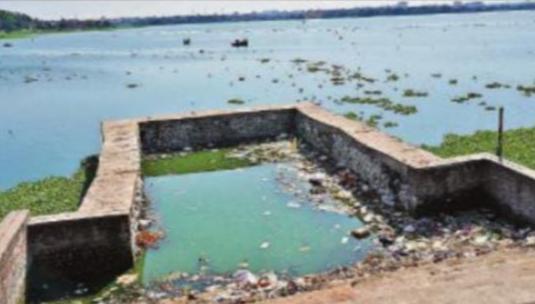
Kanke Dam was developed by the British. The work of the construction was completed in 1954. Kanke Dam is famous for bathing, boating, fishing, and supplying water for drinking purposes to thousands of people in Ranchi, the capital city of Jharkhand.
Today, a vast area of Kanke Dam is packed up by water hyacinth. It has covered its water in several places making it become poisonous. Hyacinth bulbs pack a hidden punch with calcium oxalate crystals and a toxic alkaloid, lycorine.
These substances are no joke—they can cause real harm if ingested or if they come into contact with skin or mucous membranes. Water hyacinth has a variety of negative impacts once introduced into a freshwater environment. it forms dense, impenetrable mats which clog waterways, making boating, fishing, and almost all other water activities, impossible.
It also reduces biodiversity by crowding out native plants at the water's surface. Water hyacinth can completely cover lakes and wetlands, outcompeting native aquatic species, reducing oxygen levels for fish, and creating an ideal habitat for disease-carrying mosquitoes.
Large infestations of water hyacinth can prevent river transport, and fishing, damage bridges, and clog dams. Experts say hyacinths grow mainly because water is not cleaned.
To eradicate or control water hyacinth, physical, chemical, and biological methods are widely applied throughout the world.
The physical method is employed by directly harvesting, cutting, and removing the plant using machines or manual removing by hands and hand tools.
Chemicals (herbicides and pesticides), which are either conventional or nonconventional can be applied directly or indirectly in the infested areas to eradicate or reduce the growth of the weed. Biological methods involve applying arthropods and pathogens to the infested areas.
Arthropods feed the leaves of water hyacinth but pathogens make the plant infected by diseased and finally decompose by bacterial actions. The most common and effective arthropods are weevils, pathogens, bacteria, fungi, and viruses.
Although the most advisable are preventive control methods, the application of integrated control methods is advised. Lake Tana has been invaded by water hyacinths since 2011. Currently, the expansion rate of water hyacinth is too severe which requires coordination of all stakeholders to control it.
The science of water hyacinth management is known but the knowledge of how to apply the integrated water hyacinth control approaches is challenging.
Experts say the spreading of water hyacinth can be effectively stopped and eliminated by Vedic Srijan LLP, an Indian startup registered with MCA vide Company which has invented Cownomics technology to contain it.
As such, to rejuvenate Kanke Dam, concerned authorities of the state government can contact Madhukar Swayambhu and the following site.
https://medium.com/@dreamzcoderdgl/cownomica-tradition-and-modern-ecology-95d38902da2a
https://medium.com/@dreamzcoderdgl/cownomica-tradition-and-modern-ecology-95d38902da2a
Supplier of drinking water to thousands of people in Ranchi, the capital city of Jharkhand. Kanke Dam grows water hyacinth. JharkhandStateNews.com